Exciting info for the team of Project Holodeck, Razer is now an official sponsor. The company, which was founded in 1998 and manufacturers PC peripherals for hardcore gamers, will supply the Holodeck team with hardware pertinent to the project and offer a direct line for technical inquiries. The announcement comes shortly after the Holodeck team got their hands on the latest Oculus Rift prototype. I spoke with Project Holodeck producer James Iliff about the sponsorship and the latest developments with the project.
Project Holodeck, lead by Nathan Burba, is an effort out of USC to create a platform for virtual reality games. According to the team, the goal of Project Holodeck is to “bring 360-degree 6-DOF full-body virtual reality out of the research lab and into a fun, accessible consumer gaming platform.” The Holodeck will give players a 20×20 foot play space capable of 1:1 movement; this means that if a player walks three feet forward in real life, they will move three feed forward in the virtual world. Inside this space, players will don a head mounted display to immerse them in a virtual world. You can read lots more about Project Holodeck here.
The team shared with me a brand new video which gives us a glimpse of some behind-the-scenes work and thoughts from the team:
Razer Sponsorship for Project Holodeck
The Razer hardware that is most appealing to the Project Holodeck team is the Hydra, a motion-sensing peripheral similar to the Wiimote and PlayStation Move. What sets the Hydra apart however is accuracy. While the Move and Wiimote use optical tracking systems, the Hyrda uses magnetic motion sensing which affords a full six degrees of motion sensing (up, down, side-to-side, roll, pitch, and yaw). The company says that the Razer Hydra is accurate down to a millimeter. The unit retails for $100.
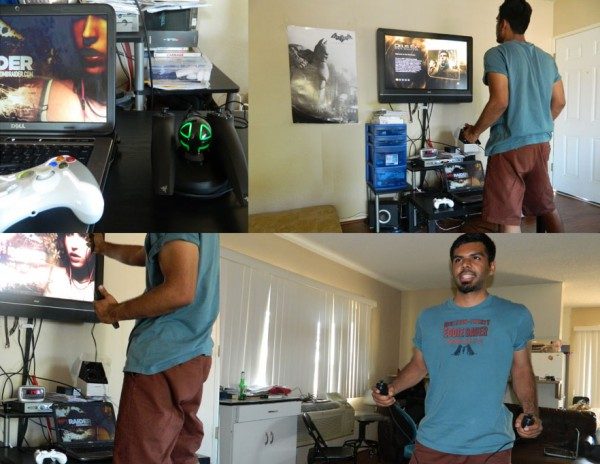
Razer will provide the Project Holodeck team with Hydras and developer-level support to aid the team in integrating the motion sensing units into the Holodeck platform. The Holodeck team says that the Hydra is an ideal solution for their needs:
We’re absolutely enamored with the Razer Hydra. It gives us the speed and precision needed for the depth of gameplay we’re trying to create. With Hydra, we have much higher precision magnetic tracking of two points with 6-degrees of freedom, allowing us to explore realistic avatar embodiment in virtual reality like never before.
Kinect Woes
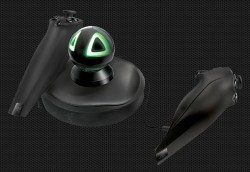
Project Holodeck was originally going to use a multi-Kinect system for tracking players in the game space but as Project Lead James Iliff tells me, the Kinect wouldn’t cut it for the level of virtual reality fidelity that the team hopes to achieve.
“…the Kinect hardware is extremely lacking in fidelity. Every point the Kinect tracks is filled with unmanageable jitter, rendering the data useless for anything other than the most simple of interactions. We tried very hard to get around this with several software algorithms we wrote, to get multiple Kinects to communicate with each other, however this did not really make anything more accurate unfortunately.”
Originally the multi-Kinect system would track skeletal positioning — that information would be used to allow players to interact with the game world. Given the difficulties with the Kinect the Project Holodeck team has since switched to a PlayStation Move and Razer Hydra setup. The Move is mounted to a helmet and tracked with a camera to indicate player position within the game world. The Hydra base is also attached to the helmet, allowing accurate tracking of the player’s hands no matter where they are in the play space. These two systems provide information that allows a computer to understand where the player is standing in the virtual space and where their hands are. The computer can then place the player’s avatar accurately in the virtual world and allow them to interact with virtual objects.
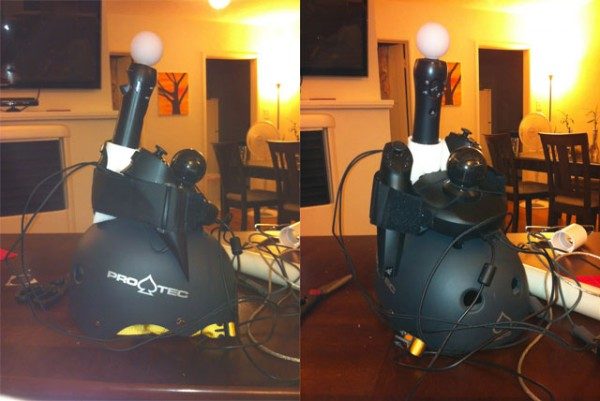
“Imagine being in the Oculus Rift head-mounted display, and looking down and seeing the virtual arms of your avatar move in tandem with your real body? This is exactly what we’re doing in Wild Skies, where players can move, jump, shoot, and otherwise interact within a complete 360-degree full-body virtual play space, all taking place on the deck of a nuclear powered steampunk-style airship,” reads the sponsorship announcement from the Holodeck team.
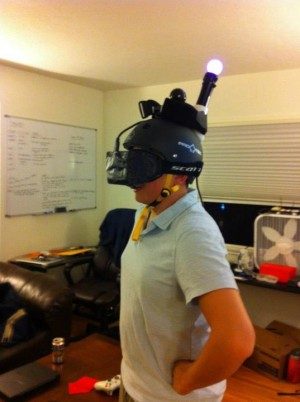
Wild Skies is the first virtual reality game that the team is making for the Holodeck. Two players will traverse a vast world on an airship, doing battle with pirates and other foes. Accurate hand-tracking means players can operate virtual objects within the game, ” in Wild Skies, the Hydra allows each player to interact with ship components in a profoundly realistic and natural way, such as the subtle motion of turning a helm, or aiming and firing a cannon, or adjusting a throttle to increase speed of transport,” continues the sponsorship announcement.
Back when the team planned on using Kinects, they’d hoped they could do full skeletal tracking, allowing live animation of the player’s avatar. The Move and Hydra system that they are now using only allows tracking of the overall position of the player and of the players hands. For now they are using a canned animation for leg movement, but Iliff tells me that to enhance realism they hope to add proper positioning there as well.
“Currently we have use traditional animation for the legs (because we have no trackers on the legs), so it’s not full avatar embodiment yet, but we want to incorporate simple magnetic trackers on the ankles given enough range, so we can actually track all your limbs with pinpoint accuracy! (this is what Kinect promises to do but fails)”
First Test of the Oculus Rift Prototype
The Oculus Rift is a 3D head mounted display which seeks to immerse players in virtual reality games. Thanks to a large field-of-view and low latency headtracking, the HMD makes players feel like they are part of game worlds, rather than merely peering into a game world through a screen. Project Holodeck is using the Rift for the display component of their platform.
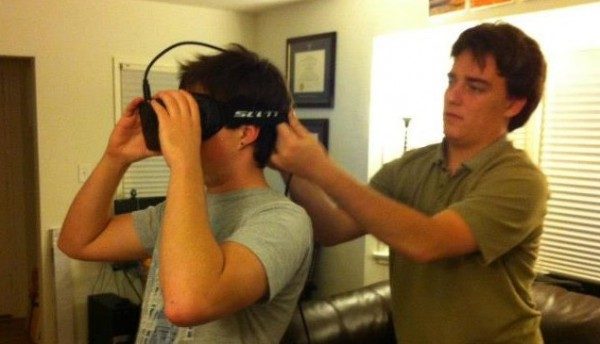
At the end of August Palmer Luckey, the man behind the Oculus Rift head mounted display and lead hardware engineer for Project Holodeck, gave the team their first hands-on with the latest Rift prtotoype. Iliff, who has worked with Luckey on past projects, tells me that the Rift impressed him — as it has many others who have tried it.
“I’ve been using [Luckey’s] HMDs for a few years now so I thought I would be jaded, but I was pleasantly surprised to see that the latest Rift prototype is even better than the last one I tried in April. I found myself staring at a pile of virtual rocks [in the game Rage] for about half an hour!”
Iliff’s impressions mirror what John Carmack has said about the potential of virtual reality. Carmack, who helped put the Oculus Rift on the radar by demoing it at E3, says the virtual reality helps bring video game art to life. What would otherwise be an unexciting wall (or pile of rocks in Iliff’s case) is suddenly a lifelike object; the artist’s vision represented faithfully, according to Carmack.
Started as a small project by Luckey, the Rift quickly snowballed into one of the top grossing Kickstarter campaigns raising over $2.4 million. Oculus LLC, the company formed by Luckey, will be distributing more than seven thousand Oculus Rift developer kits to supporters of the campaign this December. The company hopes to launch a consumer version of the head mounted display in 2013.
Nathan Burba, the Project Holodeck lead, shares his experience with the Oculus Rift:
The Rift expands on the work I have seen from Palmer in the past. It is ultra lightweight and very easy to strap to the head. When I put the Rift on I really feel like I was entering a game world. The field of view is incredible. Immediately I felt this odd dreamlike sensation as I began to look around. When you’re “inside the game world” you can re-focus your eyes freely just like you might do in real life. You can peer into the distance checking out an in-focus object while objects in the foreground remain out of focus. You can then refocus to inspect closer objects. The demo that we experienced was a level from id Software’s RAGE. It looked absolutely gorgeous. As I walked past objects I got a sense of 3D depth and “fullness” that had only one analogue: reality.
The Project Holodeck team will use some of the earliest available Oculus Rift developer kits.
Stay tuned to Road to Virtual Reality for more developments on Project Holodeck.







